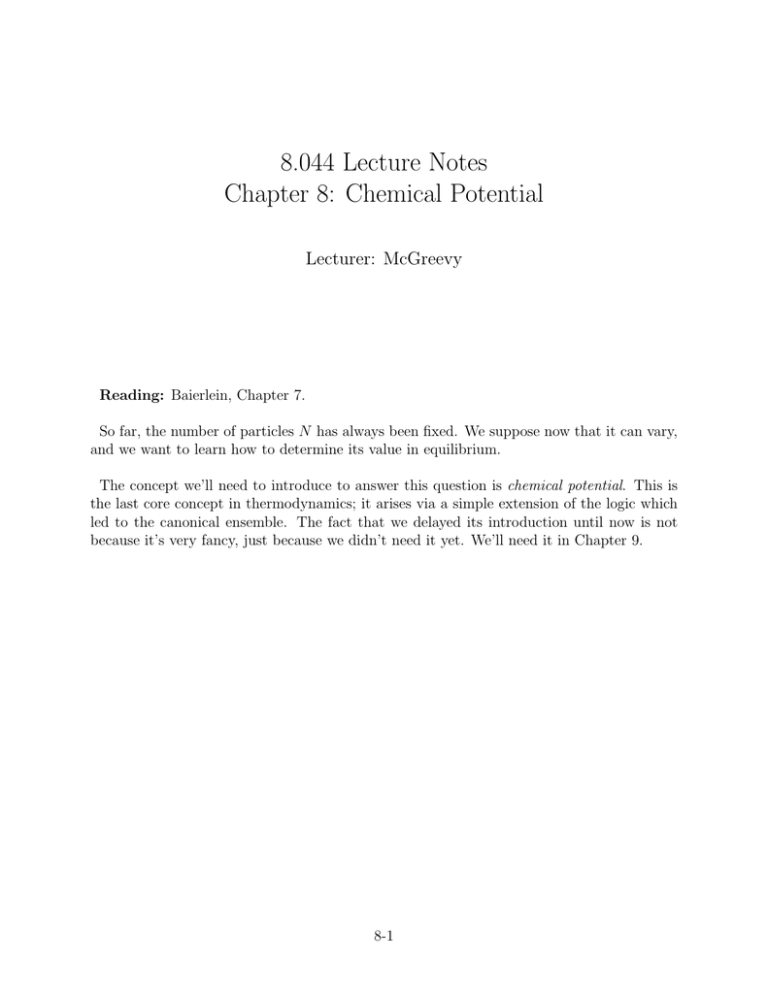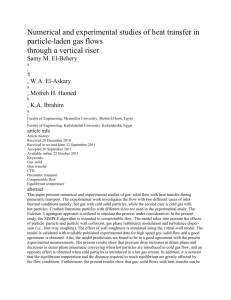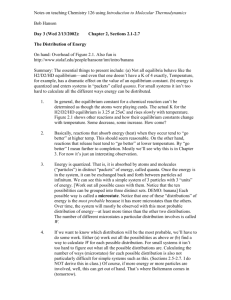8.044 Lecture Notes Chapter 8: Chemical Potential Lecturer: McGreevy
advertisement

8.044 Lecture Notes
Chapter 8: Chemical Potential
Lecturer: McGreevy
Reading: Baierlein, Chapter 7.
So far, the number of particles N has always been fixed. We suppose now that it can vary,
and we want to learn how to determine its value in equilibrium.
The concept we’ll need to introduce to answer this question is chemical potential. This is
the last core concept in thermodynamics; it arises via a simple extension of the logic which
led to the canonical ensemble. The fact that we delayed its introduction until now is not
because it’s very fancy, just because we didn’t need it yet. We’ll need it in Chapter 9.
8-1
Motivating examples
Some situations where the number of particles of a given type is not fixed, and needs to be
determined:
• Phase equilibrium
Vessel of water at 100◦ C:
Atoms in the gas can join the liquid, and vice versa. Ngas not fixed. Nliquid not fixed.
N = Ngas + Nliquid is fixed.
• Chemical equilibrium
Beaker with solution:
A + B AB
NA , NB , NAB not fixed
NA + NAB and NB + NAB fixed.
For more on these examples, see Baierlein Chapters 11 and 12, or 8.08, or a chemistry class.
We’ll introduce chemical potential in a simpler example.
8-2
• Diffusion of a monatomic ideal gas against gravity
Put the whole system at temperature T . There is a
fixed number of particles in the container:
Ntotal ≡ Nl + Nu
is fixed.
Q: what’s the most probable Nl , Nu ?
What happens? Two wrong answers:
• 8.01: a big pile on the floor.
• 8.044, so far: ignore gravity. Density and pressure the same everywhere.
Nl atoms in lower volume,
p(Nl , Nu ) ≡ Prob
Nu atoms in upper volume
1
=
·
Z
|{z}
X
e−βEstate
states with Nl (Nu ) in lower (upper) volume
sum over all states with any Nl , Nu , Ntot fixed
=
Z(Nl , Nu )
Z
[ More explicitly: Z =
Ntot
X
Z(Nl , Nu = Ntot − Nl ). ]
Nl =0
Estate =
1 + 2 + ... + Nl
|
{z
}
u + u2 + ... + uNu
{z
}
|1
+
single-particle energies for ideal gas in Vl .
single-particle energies for ideal gas in Vu – includes an extra mgh term
This extra potential energy for particles
Z in the
Z upper chamber means that the partition
2
3
function for one u particle is: Zu (1) =
d x d3 p e−β (p +mgh) . Note that it’s still an ideal
Vu
gas in that the energy doesn’t depend on the separations between the u particles. This
constant potential energy matters because we are comparing it to that of the particles in
the lower chamber – it’s the difference in potential energy between upper and lower which
matters.
Nu
Nl 2πmkB T 3/2
2πmkB T 3/2 −βmgh
Vl
Vu
e
h2
h2
Z(Nu , Nl ) =
·
Nl !
Nu !
|
{z
} |
{z
}
≡Zl (Nl )
p(Nl , Nu ) =
≡Zu (Nu )
Zl (Nl )Zu (Nu )
Z
[End of Lecture 20.]
8-3
For a macroscopic system, we expect that this probability distribution will be well-peaked around the average
value. Plotting the function, we see that this is the case:
(Exercise: compute the variance as a function of N .)
To find hNl i, we need the maximum of
ln p(Nl , Nu = Ntot − Nl ):
0=
∂ ln Zl (Nl ) ∂ ln Zu (Nu )
∂ ln p(Nl , Nu )
=
+
∂Nl
∂Nl
∂Nl
∂ ln Zl (Nl )
dNu ∂ ln Zu (Nu )
=−
∂Nl
dNl
∂Nu
(Nu = Ntot − Nl =⇒
dNu
dNl
= −1 ) .
Therefore the maximum probability occurs when
∂ ln Zl (Nl )
∂ ln Zu (Nu )
=
.
∂Nl
∂Nu
(1)
The LHS only depends on the lower system, the RHS depends only on the upper system;
we’ve shown that when they are in equilibrium, their ∂N ln Zs are the same. Notice the
similarity of the logic here to our derivation of the zeroth law – when two systems are in
equilibrium, their temperatures are equal. This quantity ∂N ln Z (which will acquire a name
in a moment) plays the role for N that T plays for E.
Now, recall that F = −kB T ln Z. We can rewrite (1) as
∂Fl
∂Nl
=
T,Vl
Since N is a discrete variable, what we mean by
∂F
∂N
=
∂Fu
∂Nu
∂F
∂N
T,Vu
here is
∆F
with ∆N = 1
∆N
= F (T, V, N ) − F (T, V, N − 1)
We define the chemical potential as
∂F
µ(T, V, N ) ≡
= F (T, V, N ) − F (T, V, N − 1) .
∂N T,V
We have shown that in equilibrium,
µl = µu .
That is, µ is uniform throughout the system.
8-4
(2)
Comments about µ
• µ is the free energy cost for adding one more particle (at constant T, V ).
• Recall: at constant T, V , equilibration proceeds by minimizing F .
Suppose µl < µu . Then we can lower the total free energy by removing a particle from
u and adding it to l.
Therefore, µl 6= µu means we are not in equilibrium. The particles will diffuse between
u and l until µl = µu .
Recall: T told us the direction of heat flow when we put two systems of different
temperatures in contact. Similarly, µ tells us the direction of particle flow.
• In the phase equilibrium example, µliquid = µgas in equilibrium. Also: Tliquid = Tgas and
Pliquid = Pgas .
• Note:
F = Fl + Fu = −kB T ln (Zl Zu )
| {z }
∝p(Nl ,Nu )
Therefore: equilibrium ⇔ max probability ⇔ min F .
8-5
Back to the gravity example:
You can recognize that these concepts transcend this example with an ideal gas in a constant
gravitational field.
But let’s return to this example and work out the consequences of imposing equilibrium:
!
Nl
∂
Z1
∂Fl
= −kB T
ln
µl =
∂Nl
∂Nl
Nl !
∂
(Nl ln (Z1 ) − Nl ln Nl + Nl )
= −kB T
∂Nl
Z1
Vl −3
= −kB T ln
= −kB T ln
λ
Nl
Nl th
[This manipulation happens frequently and is worth recording: we just showed that
ZN
∂
If Z = 1 then
ln Z = ln
N!
∂N
Z1
N
.]
So:
∂Fu
∂Nu
Vu −3 −βmgh
λ e
Nu th
= −kB T ln
Vu −3
λ
= mgh − kB T ln
Nu th
µu =
Therefore
µl = µu
⇔
⇔
Vl
Vu −βmgh
=
e
Nl
Nu
Nu
Nl −mgh/kB T
=
e
Vu
Vl
Lower density higher up! ρu < ρl . Another good check: turning off gravity g → 0 restores
ρu = ρl .
This is the ‘Law of Isothermal Atmospheres’. Problem Set 10 gives a more realistic accounting of the density of air as a function of height in the atmosphere.
For simplicity, set Vu = Vl .
8-6
Note that if mgh = 0 , hNl i = N/2. If mgh > 0, Nl > N/2 > Nu .
If µu > µl , Nl < Nleqbm , atoms diffuse from u to l.
If µu < µl , Nl > Nleqbm , atoms diffuse from l to u.
Just as energy diffuses in response to a temperature gradient, particles diffuse in response
to a gradient of chemical potential.
e.g. If we start with equal densities at u and l, then µu > µl by mgh and the atoms with
diffuse downward until this difference is equalized.
Chemical potential measures the tendency to diffuse.
Increasing density, N/V increases µ.
Increasing the energy difference mgh increases µ.
=⇒ particles diffuse away from large density N/V , and from large mgh.
Note that once N is allowed to vary
dF = −SdT − P dV +
µ
dN
|{z}
∂F
=( ∂N
)T,V
dE = T dS − P dV + µdN
8-7
=⇒ µ =
∂E
∂N
V,S
Note that µ < 0 for classical ideal gas:
µ = −kB T ln
V
N λ3th
1
Why is this? µ is the energy to add a particle, keeping the entropy constant. Examining the
formula for the entropy shows that keeping the entropy constant while increasing N forces
you to lower the temperature. The system over-compensates for the extra kinetic energy.
The differentials of all four thermodynamic potentials (E, F, G, H) acquire a +µdN term.
We could now define four more th. potentials by Legendre transforming by subtracting µN ,
to change +µdN to −N dµ.
1
As we will in Chapter 9, if the argument of the logarithm here is not much bigger than 1 (meaning that
the logarithm is positive: ln(x > 1) > 0), it’s not a classical ideal gas.
8-8






